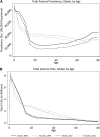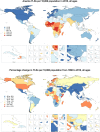A systematic analysis of global anemia burden from 1990 to 2010
- PMID: 24297872
- PMCID: PMC3907750
- DOI: 10.1182/blood-2013-06-508325
A systematic analysis of global anemia burden from 1990 to 2010
Abstract
Previous studies of anemia epidemiology have been geographically limited with little detail about severity or etiology. Using publicly available data, we estimated mild, moderate, and severe anemia from 1990 to 2010 for 187 countries, both sexes, and 20 age groups. We then performed cause-specific attribution to 17 conditions using data from the Global Burden of Diseases, Injuries and Risk Factors (GBD) 2010 Study. Global anemia prevalence in 2010 was 32.9%, causing 68.36 (95% uncertainty interval [UI], 40.98 to 107.54) million years lived with disability (8.8% of total for all conditions [95% UI, 6.3% to 11.7%]). Prevalence dropped for both sexes from 1990 to 2010, although more for males. Prevalence in females was higher in most regions and age groups. South Asia and Central, West, and East sub-Saharan Africa had the highest burden, while East, Southeast, and South Asia saw the greatest reductions. Iron-deficiency anemia was the top cause globally, although 10 different conditions were among the top 3 in regional rankings. Malaria, schistosomiasis, and chronic kidney disease-related anemia were the only conditions to increase in prevalence. Hemoglobinopathies made significant contributions in most populations. Burden was highest in children under age 5, the only age groups with negative trends from 1990 to 2010.
Figures





Comment in
-
Anemia: a comprehensive global estimate.Blood. 2014 Jan 30;123(5):611-2. doi: 10.1182/blood-2013-12-543405. Blood. 2014. PMID: 24482500
References
-
- Sachdev H, Gera T, Nestel P. Effect of iron supplementation on mental and motor development in children: systematic review of randomised controlled trials. Public Health Nutr. 2005;8(2):117–132. - PubMed
-
- Glazer Y, Bilenko N. [Effect of iron deficiency and iron deficiency anemia in the first two years of life on cognitive and mental development during childhood] [in Hebrew]. Harefuah. 2010;149(5):309–314, 335. - PubMed
-
- Haas JD, Fairchild MW. Summary and conclusions of the International Conference on Iron Deficiency and Behavioral Development, October 10-12, 1988. Am J Clin Nutr. 1989;50(3):703–705. - PubMed
-
- McCann JC, Ames BN. An overview of evidence for a causal relation between iron deficiency during development and deficits in cognitive or behavioral function. Am J Clin Nutr. 2007;85(4):931–945. - PubMed
-
- Beard JL, Connor JR. Iron status and neural functioning. Annu Rev Nutr. 2003;23:41–58. - PubMed
Publication types
MeSH terms
Grants and funding
LinkOut - more resources
Full Text Sources
Other Literature Sources
Medical

